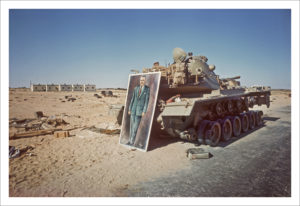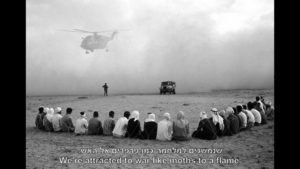A group of young paratroopers stands shoulder to shoulder, some smiling as others look up in awe at a point outside the frame.
The iconic black-and-white photograph was taken by legendary photographer Micha Bar-Am, and captures the moment that Israel gained control of Jerusalem’s Old City during the 1967 Six-Day War.
According to Bar-Am, the soldiers are looking up at the Dome of the Rock as an Israeli flag is being hoisted over the newly conquered Temple Mount. The flag was quickly taken down a few minutes later upon orders of then-Defense Minister Moshe Dayan, who feared it would inflame the Muslim world.
Seated outside a new exhibition at the Tel Aviv Museum of Art dedicated to a documentary film on his work, Micha Bar-Am and his wife, Orna, reflected on a lifetime of chronicling Israeli history.

Israeli photographer Micha Bar-Am and his wife, Orna, who created a monumental archive of his work, on June 12, 2022. (Gil Mezuman)
“I had the naïve hope that photography could make things better,” Micha Bar-Am told The Media Line. “The way I saw it, there was something very positive about photography. But later on, I understood that when I received a photography prize, perhaps it made me feel better but it didn’t do any good to the person being photographed.”
The German-born Israeli artist is considered to be one of the pillars of photojournalism in Israel. Over his decades-long career, Bar-Am, 91, has photographed some of the most striking moments of Israel’s history, including the Six-Day War, the trial of Adolf Eichmann and the Yom Kippur War.
In 1968, he joined the prestigious international photographic cooperative Magnum Photos, and also became the photographic correspondent in Israel for The New York Times, a position he held until 1992. Bar-Am’s work would also go on to appear on the covers of some of the most important publications, including Time magazine and Paris Match.
“I view myself as a chronicler, which includes [documenting] things that are less pleasant,” Bar-Am said. “I don’t plan to start criticizing the country that I love the most and in which I hope more positive things will transpire than what is happening now.”
“With regard to political subjects I try not to go too in-depth,” he added. “What’s happening is happening; others can interpret it and do with it what they will.”
An upcoming exhibition at the Tel Aviv Museum of Art examines the photojournalist’s work via award-winning filmmaker Ran Tal’s new documentary “1341 Frames of Love and War,” which recently premiered at the Docaviv film festival.
The entire film is told through the lens of Bar-Am through a collage of still images taken from an archive of more than half a million negatives. It explores the memories of atrocities and wars that Bar-Am documented, along with the important family milestones over his decades-long career.
Narrated by conversations between the filmmaker and his wife, it is clear that Orna Bar-Am, herself an artist, was instrumental in preserving her husband’s work. In fact, she organized all of his pictures into a monumentally detailed archive.
“He would go out to shoot and I would write things down,” Orna Bar-Am told The Media Line. “Every picture he took received a number, all in chronological order, with details and a subject. I wrote everything down in a thick notebook. I have three of these work logs. I hadn’t studied archiving, but the photos were piling up and I had to find an order in that.”

Sinai during the 1967 Six-Day War. (Micha Bar-Am)
All in all, she archived more than half a million negatives: 250,000 black-and-white shots as well as 250,000 color photos. The couple is now hoping to find a buyer for their invaluable collection.
“We invested 60 years of work into making this archive,” she said. “While donating it would be nice, we would also like to be compensated.”
Film Asks ‘Where Does Memory Begin?’
What is the connection between memory and photography? How does one document the documenter of history?
These are some of the thorny questions acclaimed filmmaker Ran Tal set out to answer when he embarked upon his documentary, “1341 Frames of Love and War.”
“For me, Micha Bar-Am raises some big questions like: What is history?” Tal told The Media Line. “Where does memory begin and where does photography end? Do we remember the photo or do we remember what was? Is there a conflict between what we remember and what was photographed? It’s become even crazier with the tsunami of images that now surrounds us.”
Tal has created several documentaries that explore life in Israel from social and historical perspectives. His 2020 film, “What If? Ehud Barak on War and Peace,” followed the controversial former Israeli prime minister as he sought to shape the history of the State of Israel.
It was after creating this movie that Tal decided to focus on Micha Bar-Am.
“I wanted to make a film about the person who records history,” he said. “For me, Micha Bar-Am was one of the greatest chroniclers in this area.”
It took three years of conversations with the couple and sifting through hundreds of thousands of negatives, as well as reading through Orna Bar-Am’s logs, to reach the final result.
Tal is hopeful that the film will be released in the United States by the end of the summer, though the details have yet to be finalized.
It goes without saying that the world of photojournalism has shifted significantly in recent decades. With the advent of smartphones and digital photography, the medium has become nearly universally accessible and images can be viewed and shared instantaneously.
This is a far cry from how Micha himself worked with traditional film.
“Micha shot in color from the very first day,” his wife noted. “At the time, Kodak had color film but there were no labs in Israel so we had to send the film to Germany to be developed. We’d get it back as slides and frames six weeks later.”

An image from the Tel Aviv Museum’s exhibition “The Last Photograph: Ran Tal after Micha Bar-Am.” (Tel Aviv Museum of Art)
Tel Aviv Museum Exhibition Explores Bar-Am’s Work
In its upcoming exhibition, “The Last Photograph: Ran Tal After Micha Bar-Am,” the Tel Aviv Museum of Art disassembles Ran Tal’s documentary and transforms it into a multi-station video installation. Visitors can move around the gallery space freely and view segments of the film at different stations.
Slated to open to the public on Friday, the exhibition format is experimental, according to curator Dr. Noam Gal.
“Ran Tal recorded such amazingly intimate conversations with Micha and his wife and their kids that I wanted to have [this exhibition] be as intimate as possible,” Gal said, adding that he wanted “to have these conversations, the most important ones, in the show.”
As for Bar-Am, he said that his memories would have long faded had it not been for his wife’s prodigious archiving efforts.
“I concentrated on things that interested me and this was part of the adventure of life,” he said. “At 92 years of age, I can at least say that I’ve had a positive and interesting life. I’ve left behind a body of work that anyone can perceive as they wish.”
“The Last Photograph: Ran Tal After Micha Bar-Am,” will remain on display from June 17 to December 17, 2022, at the Tel Aviv Museum of Art. Ran Tal’s documentary film, “1341 Frames of Love and War,” will be released in Israeli cinemas on June 23 and also will be screened at the upcoming Sheffield DocFest in England. The film is also slated to be released in North America by the end of the summer.
See also “Micha Bar-Am Has Photographed Israel’s History [3].”